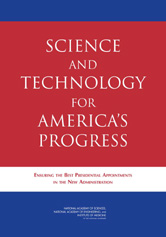|
Highlights:
 This Week in PNAS This Week in PNAS
Highlights from the recent edition of Proceedings of the National Academy of Sciences (PNAS), the Academy's scientific journal
 Biographical Memoirs Biographical Memoirs
Access more than 1,000 biographies of leading U.S. scientists including Thomas Edison, Alexander Graham Bell, Margaret Mead, Louis Agassiz, and Joseph Henry
News:
 Traumatic Brain Injury Linked to Long-Term Health Problems Traumatic Brain Injury Linked to Long-Term Health Problems
Dec. 4, 2008: Military personnel who suffer severe or moderate traumatic brain injury face an increased risk for developing several long-term health problems, including Alzheimer's-like dementia, aggression, memory loss, and depression.
 EPA's Risk Assessment Process Should Be Expanded EPA's Risk Assessment Process Should Be Expanded
Dec. 3, 2008: The U.S. Environmental Protection Agency's process of generating risk assessments is bogged down by unprecedented challenges and should be streamlined. To improve its use as a decision-making tool, this should include ensuring that risk assessments make best use of appropriate available science, are technically accurate, and tailor the assessment to the specific needs of the problem.
 Changes to Medical Residents’ Hours, Workloads, and Supervision Needed Changes to Medical Residents’ Hours, Workloads, and Supervision Needed
Dec. 2, 2008: To promote patient safety, a new report from the Institute of Medicine recommends reducing the maximum number of hours that medical residents can work without a break for sleep to 16.
 Costs of NASA's Constellation Science Missions Could Be Too High Costs of NASA's Constellation Science Missions Could Be Too High
Nov. 24, 2008: A new report from the National Research Council finds that while many proposed science missions for NASA's new Constellation program are scientifically sound, they could prove to be prohibitively expensive.
 Report Offers Plan to Improve Weather and Climate Monitoring Report Offers Plan to Improve Weather and Climate Monitoring
Nov. 20, 2008: A more integrated and effective nationwide meteorological and chemical weather network is needed that measures atmosphere conditions at various heights and scales.
>> More News
|
|
|

|
|
Academies Offer Advice to President-Elect Obama on Filling S&T Posts
As President-elect Barack Obama prepares to take the helm, he should use the best available science and scientists to help manage the nation’s current and future issues, such as climate change, alternative energy, veterans' health, and the nation's infrastructure, advises a recent report from the National Academy of Sciences, National Academy of Engineering, and Institute of Medicine. Read more ...
|
 |
National Academy of Sciences
500 Fifth Street, NW
Washington, DC 20001
Terms of Use | Privacy Policy
Contact Us | Site Map
| | | |
|







